Network-Aware Gaussian Mixture Models for Multi-Objective SD-WAN Controller Placement
Abstract
1. Introduction
- Propose a hybrid topology-aware distance metric that integrates geographical, latency, topological, and reliability dimensions with adaptive weighting, achieving noticeable reduction in average control latency and improvement in worst-case latency compared to traditional Euclidean distance-based approaches.
- Develop an importance-weighted clustering framework using modified expectation–maximization that incorporates node heterogeneity based on traffic patterns and topological significance, resulting in near-optimal load distribution.
- Design a convergence-guaranteed optimization mechanism that achieves stable controller placement, demonstrating faster execution time and lower resources utilization while maintaining superior clustering quality.
- Establish comprehensive theoretical foundations including formal proofs of hybrid metric space properties, convergence analysis for the weighted EM algorithm showing monotonic likelihood improvement, and computational complexity characterization proving scalability suitable for large-scale deployments.
- Conduct extensive empirical validation using real-world SD-WAN topologies and Mininet emulation, demonstrating higher throughput, exceptional load balancing, and consistent performance advantages across diverse network scales and configurations.
2. Background and Related Work
2.1. Multi-Objective Optimization Approaches
2.2. Machine Learning and AI-Driven Approaches
2.3. Clustering-Based Methodologies
2.4. Distance Metrics and Network-Aware Approaches
2.5. Reliability and Fault Tolerance Considerations
2.6. Performance Evaluation and Benchmarking
2.7. Research Gaps and Open Challenges
3. Proposed Method
3.1. Problem Formulation
- α + β + γ + δ = 1 (weight parameters normalization).
- = 1 (mixing coefficients normalization).
- = 1, ∀i (responsibility normalization).
- Σk must be positive semi-definite (covariance matrix constraint).
- K ≤ n (number of clusters cannot exceed number of nodes).
- ε > 0 typically in range [10−6, 10−3] for practical convergence.
3.2. Novel Hybrid Distance System
3.2.1. Geographic Distance (
3.2.2. Latency Estimation (
3.2.3. Link Cost (
3.2.4. Link Reliability (
| Algorithm 1 Compute Hybrid Network-Aware Distance Matrix (D_NA) |
| Require: Node coordinates (φi, λi) for i = 1,…,N Require: Weight parameters α, β, γ, δ Require: Earth radius r, propagation speed v, base cost c0, cost factor c1, decay factor κ Ensure: Distance matrix D_NA ∈ ℝn×n 1: for each ordered pair of nodes (i, j) from 1 to N do 2: Δφ ← φj − φi 3: Δλ ← λj − λi 4: a ← sin2(Δφ/2) + cos(φi)·cos(φj)·sin2(Δλ/2) 5: d_geo(i,j) ← 2·r·arcsin(√a) ▷ Haversine distance 6: d_lat(i,j) ← d_geo(i,j) / v ▷ delay based on geographic distance 7: d_cost(i,j) ← c0 + c1·d_geo(i,j) ▷ cost based on geographic distance 8: R(i,j) ← exp(−κ·d_geo(i,j)) ▷ reliability/decay factor 9: end for 10: ▷ Normalize components to a consistent scale (e.g., [0, 1]) 11: for each ordered pair of nodes (i, j) from 1 to N do 12: d′_geo(i,j) ← Normalize(d_geo(i,j)) 13: d′_lat(i,j) ← Normalize(d_lat(i,j)) 14: d′_cost(i,j) ← Normalize(d_cost(i,j)) 15: R′(i,j) ← Normalize(R(i,j)) ▷ Optional: normalize reliability if δ ≠ 0 16: D_NA(i,j) ← α·d′_geo(i,j) + β·d′_lat(i,j) + γ·d′_cost(i,j) + δ·R′(i,j) 17: end for D_NA |
3.3. Sensitivity Analysis of Hybrid Distance Metric Parameters
3.4. NA-GMM-Based Controller Placement Strategy
3.4.1. Theoretical Foundation
- ∈ [0, 1] is the mixing coefficient for component , satisfying =1;
- ∈ is the mean vector (center) of the -th Gaussian distribution;
- ∈ is the covariance matrix, capturing the spread of the distribution;
- denotes the multivariate normal distribution evaluated at .
3.4.2. Multivariate Normal Distribution
- ∣Σ∣ denotes the determinant of the covariance matrix.
- Σ−1 is the inverse of the covariance matrix.
3.4.3. Probabilistic Clustering and Soft Assignments
- Some nodes may straddle the boundaries of multiple controller regions.
- Traffic loads and link reliability may vary dynamically.
- The network may require flexible controller domains to accommodate fault tolerance or dynamic reallocation.
3.4.4. Parameter Estimation via Expectation–Maximization (EM)
- The E-step (Expectation) computes the responsibilities γik that represent the probability of node i belonging to controller cluster k. These values incorporate both the geometric likelihood of the assignment based on the current cluster parameters and the topology-conscious distance relationships established in the preprocessing phase. See Figure 3.
- 2.
- M-step (Maximization); this step updates the model parameters {μk, πk, Σk} based on the computed responsibilities, embodying the principle that controller characteristics should reflect the nodes they are expected to serve. The effective sample size represents the weighted number of nodes assigned to cluster k. This value accounts for fractional assignments by summing the responsibility values rather than simply counting hard assignments. Clusters with higher effective sample sizes indicate areas of the network (domain) with dense node populations or strong connectivity patterns. See Figure 4.
3.4.5. Convergence Monitoring and Termination
3.4.6. Final Assignment and Solution Extraction
| Algorithm 2 Network-Aware GMM (NA-GMM) Controller Placement |
| Require: • Feature vectors {xi}i=1…N • Number of clusters K • Distance matrix D_NA • Convergence threshold ε Ensure: • Controller positions {μk}k=1…K • Node–cluster responsibilities γik 1: Initialize GMM parameters for k = 1…K: μk ← I, Σk ← I, πk ← 1/K 2: repeat 3: ▷ E-step 4: for each node i ∈ {1…N} and each cluster k ∈ {1…K} do 5: γik ← πk · (xi | μk, Σk) / ∑j=1K [πj · (xi | μj, Σj)] 6: end for 7: ▷ M-step 8: for each cluster k ∈ {1…K} do 9: Nk ← ∑i=1N γik 10: μk ← (1/Nk) · ∑i=1N γik · xi 11: Σk ← (1/Nk) · ∑i=1N γik · (xi − μk)(xi − μk)T 12: πk ← Nk / N 13: end for 14: Evaluate log-likelihood L(θ) and check convergence 15: until ΔL(θ) ≤ ε 16: Assign each node i to cluster k* = arg maxk γik 17: return {μk}k=1…K and {γik}i=1…N,k=1…K |
4. Experimental Design and Results
4.1. Simulation Environment and Tools
4.1.1. Experimental Infrastructure and Software Framework
4.1.2. Network Topologies and Performance Metrics
- ACL: Measures the average latency between nodes within the same cluster, providing a gauge for the responsiveness of the network, as shown in (14).
- WCL: Captures the worst-case latency scenario within each cluster, which is crucial for understanding the potential for delay spikes; see (15).
- ICL: Following (16), assesses the latency between controllers, which has an impact on coordination and overall network performance.
- NDR: Assesses the evenness of the node distribution across clusters, which can influence network load management and resilience, as shown in (17).
4.1.3. Experimental Design and Benchmarking
4.2. Results
4.2.1. Clustering Results
4.2.2. Network Performance Results
- The process of network topology configuration in Mininet involved reconstructing the original network structure with preserved nodes, links, and connectivity patterns.
- Controller deployment involved instantiating five controllers for each algorithm and positioning them according to clustering results.
- Cluster implementation assigned network nodes to their controller clusters based on clustering decisions.
- Traffic generation and measurement used iperf3 traffic generators to simulate realistic network conditions with varying request rates.
- Data aggregation involved aggregating individual cluster throughput values to compute the average throughput for each algorithm per topology, conducting multiple simulation runs to minimize measurement variance.
- Controller Utilization (U) measures the percentage of controller capacity consumed by network traffic, calculated as [49], (18):
- Controller Load Variance (CLV) evaluates load distribution heterogeneity based on actual clustering results, computed as (19), [52]:where Ui represents individual controller utilization based on node distribution, N is the number of controllers, and Ū is the mean utilization.
- Load Imbalance Ratio (LIR) quantifies load distribution inequality [53], defined as follows (20):
4.2.3. Computational Complexity Analysis
5. Discussion
5.1. Algorithm Performance Interpretation
5.2. Practical Implications for SDN Deployment
5.3. Theoretical Contributions and Methodological Insights
6. Future Work
7. Conclusions
Author Contributions
Funding
Data Availability Statement
Acknowledgments
Conflicts of Interest
Abbreviations
| ACL | Average Controller Latency |
| ACO | Ant Colony Optimization |
| CLV | Controller Load Variance |
| CNN | Convolutional Neural Networks |
| CPP | Controller Placement Problem |
| CPSA | Controller Placement with Critical Switch Aware |
| DBSCAN | Density-Based Spatial Clustering of Applications with Noise |
| DRL | Deep Reinforcement Learning |
| EM | Expectation–maximization |
| GA | Genetic Algorithms |
| GAT | Graph Attention Networks |
| GMM | Gaussian Mixture Model |
| ICL | Inter-Controller Latency |
| IS-IS | Intermediate System to Intermediate System |
| ITZ | Internet Topology Zoo |
| LIR | Load Imbalance Ratio |
| LSTM | Long Short-Term Memory |
| MAP | Maximum A Posteriori |
| MOEA/D | Multi-Objective Evolutionary Algorithm based on Decomposition |
| NA-GMM | Network-Aware Gaussian Mixture Model |
| NDR | Node Distribution Ratio |
| NSGA-III | Non-dominated Sorting Genetic Algorithm III |
| OSPF | Open Shortest Path First |
| PSO | Particle Swarm Optimization |
| QoS | Quality of Service |
| SD-WAN | Software-Defined Wide Area Networks |
| SDN | Software-Defined Networking |
| TSN | Time-Sensitive Networking |
| WCL | Worst-Case Latency |
References
- Abdulghani, A.M.; Abdullah, A.; Rahiman, A.R.; Hamid, N.A.W.A.; Akram, B.O.; Raissouli, H. Navigating the Complexities of Controller Placement in SD-WANs: A Multi-Objective Perspective on Current Trends and Future Challenges. Comput. Syst. Sci. Eng. 2025, 49, 123–157. [Google Scholar] [CrossRef]
- Afolalu, O.; Tsoeu, M.S. Enterprise Networking Optimization: A Review of Challenges, Solutions, and Technological Interventions. Future Internet 2025, 17, 133. [Google Scholar] [CrossRef]
- Darwish, T.; Alhaj, T.A.; Elhaj, F.A. Controller placement in software defined emerging networks: A review and future directions. Telecommun. Syst. 2025, 88, 18. [Google Scholar] [CrossRef]
- Kazi, B.U.; Islam, M.K.; Siddiqui, M.M.H.; Jaseemuddin, M. A Survey on Software Defined Network-Enabled Edge Cloud Networks: Challenges and Future Research Directions. Network 2025, 5, 16. [Google Scholar] [CrossRef]
- Ateya, A.A.; Muthanna, A.; Koucheryavy, A. 5G framework based on multi-level edge computing with D2D enabled communication. In Proceedings of the 2018 20th International Conference on Advanced Communication Technology (ICACT), Chuncheon, Republic of Korea, 11–14 February 2018; pp. 507–512. [Google Scholar]
- Nunes, B.A.A.; Mendonca, M.; Nguyen, X.N.; Obraczka, K.; Turletti, T. A survey of software-defined networking: Past, present, and future of programmable networks. IEEE Commun. Surv. Tutor. 2018, 16, 1617–1634. [Google Scholar] [CrossRef]
- Hu, T.; Yi, P.; Zhang, J.; Lan, J. Reliable and load balance-aware multi-controller deployment in SDN. China Commun. 2018, 15, 184–198. [Google Scholar] [CrossRef]
- Lu, J.; Zhang, Z.; Hu, T.; Yi, P.; Lan, J. A Survey of Controller Placement Problem in Software-Defined Networking. IEEE Access 2019, 7, 24290–24307. [Google Scholar] [CrossRef]
- Hock, D.; Hartmann, M.; Gebert, S.; Jarschel, M.; Zinner, T.; Tran-Gia, P. Pareto-optimal resilient controller placement in SDN-based core networks. In Proceedings of the 2013 25th International Teletraffic Congress (ITC), Shanghai, China, 10–12 September 2013; pp. 1–9. [Google Scholar] [CrossRef]
- Xu, Y.; He, S.; Zhou, Z.; Xu, J. Redundant Path Optimization in Smart Ship Software-Defined Networking and Time-Sensitive Networking Networks: An Improved Double-Dueling-Deep-Q-Networks-Based Approach. J. Mar. Sci. Eng. 2024, 12, 2214. [Google Scholar] [CrossRef]
- Chen, L.; Lingys, J.; Chen, K.; Liu, F. Auto: Scaling deep reinforcement learning for datacenter-scale automatic traffic optimization. In Proceedings of the 2018 Conference of the ACM Special Interest Group on Data Communication (SIGCOMM ’18), Budapest, Hungary, 20–25 August 2018; pp. 191–205. [Google Scholar] [CrossRef]
- Kumari Rajoriya, M.; Gupta, C.P. SO-CPP: Sailfish optimization-based controller placement in IoT-enabled software-defined wireless sensor networks. Int. J. Commun. Syst. 2024, 37, e5757. [Google Scholar] [CrossRef]
- Asadollahi, S.; Goswami, B.; Sameer, M. Ryu controller’s scalability experiment on software defined networks. In Proceedings of the 2018 IEEE International Conference on Current Trends in Advanced Computing (ICCTAC), Bangalore, India, 1–2 February 2018; pp. 1–5. [Google Scholar] [CrossRef]
- Zhong, Q.; Wang, Y.; Li, W.; Qiu, X. A min-cover based controller placement approach to build reliable control network in SDN. In Proceedings of the NOMS 2016-2016 IEEE/IFIP Network Operations and Management Symposium, Istanbul, Turkey, 25–29 April 2016; pp. 481–487. [Google Scholar] [CrossRef]
- Papasani, A.; Varma, G.S.; Prasad Reddy, P.V.; Yannam, V.R. Enhanced capacitated next controller placement in software-defined network with modified capacity constraint. Int. J. Commun. Syst. 2025, 38, e5979. [Google Scholar] [CrossRef]
- Chaudhary, R.; Aujla, G.S.; Kumar, N.; Chouhan, P.K. A comprehensive survey on software-defined networking for smart communities. Int. J. Commun. Syst. 2025, 38, e5296. [Google Scholar] [CrossRef]
- Ospina Cifuentes, B.J.; Suárez, Á.; García Pineda, V.; Alvarado Jaimes, R.; Montoya Benitez, A.O.; Grajales Bustamante, J.D. Analysis of the Use of Artificial Intelligence in Software-Defined Intelligent Networks: A Survey. Technologies 2024, 12, 99. [Google Scholar] [CrossRef]
- Memon, S.A.; Andriukaitis, D.; Markevicius, V.; Navikas, D.; Valinevicius, A.; Zilys, M.; Ramanauskas, R.; Sotner, R.; Jerabek, J.; Klimenta, D. A Survey on Controller Placement Algorithms for IoT Networks in Smart City Environments. In Proceedings of the 2025 IEEE 12th Workshop on Advances in Information, Electronic and Electrical Engineering (AIEEE), Vilnius, Lithuania, 15–17 May 2025; pp. 1–6. [Google Scholar] [CrossRef]
- Saeedi Goraghani, M.; Afzali, M.; Sharifi, F. A Reliable and Load Balancing Controller Placement Method in Software-Defined Networks. Int. J. Commun. Syst. 2025, 38, e6059. [Google Scholar] [CrossRef]
- Bari, M.F.; Roy, A.R.; Chowdhury, S.R.; Zhang, Q.; Zhani, M.F.; Ahmed, R.; Boutaba, R. Dynamic Controller Provisioning in Software Defined Networks. In Proceedings of the 9th International Conference on Network and Service Management (CNSM 2013), Zurich, Switzerland, 14–18 October 2013; pp. 18–25. [Google Scholar] [CrossRef]
- Sahoo, K.S.; Puthal, D.; Obaidat, M.S.; Sarkar, A.; Mishra, S.K.; Sahoo, B. On the placement of controllers in software-defined-WAN using meta-heuristic approach. J. Syst. Softw. 2018, 145, 180–194. [Google Scholar] [CrossRef]
- Ahmadi, V.; Khorramizadeh, M. An adaptive heuristic for multi-objective controller placement in software-defined networks. Comput. Electr. Eng. 2018, 66, 204–228. [Google Scholar] [CrossRef]
- Firouz, N.; Masdari, M.; Sangar, A.B.; Majidzadeh, K. A Hybrid Multi-objective Algorithm for Imbalanced Controller Placement in Software-Defined Networks. J. Netw. Syst. Manag. 2022, 30, 51. [Google Scholar] [CrossRef]
- Salam, R.; Bhattacharya, A. Efficient greedy heuristic approach for fault-tolerant distributed controller placement in scalable SDN architecture. Clust. Comput. 2022, 25, 4543–4572. [Google Scholar] [CrossRef]
- Adekoya, O.; Aneiba, A. An Adapted Nondominated Sorting Genetic Algorithm III (NSGA-III) With Repair-Based Operator for Solving Controller Placement Problem in Software-Defined Wide Area Networks. IEEE Open J. Commun. Soc. 2022, 3, 888–901. [Google Scholar] [CrossRef]
- Tan, L.; Su, W.; Gao, S.; Miao, J.; Cheng, Y.; Cheng, P. Path-flow matching: Two-sided matching and multiobjective evolutionary algorithm for traffic scheduling in cloud data* center network. Trans. Emerg. Telecommun. Technol. 2022, 33, e3809. [Google Scholar] [CrossRef]
- Hou, J.; Tao, T.; Lu, H.; Nayak, A. Intelligent Caching with Graph Neural Network-Based Deep Reinforcement Learning on SDN-Based ICN. Future Internet 2023, 15, 251. [Google Scholar] [CrossRef]
- Troia, S.; Sapienza, F.; Varé, L.; Maier, G. On Deep Reinforcement Learning for Traffic Engineering in SD-WAN. IEEE J. Sel. Areas Commun. 2021, 39, 2198–2212. [Google Scholar] [CrossRef]
- Gasior, D. Self-optimizing SD-WAN. In Artificial Intelligence and Machine Learning; Soliman, K.S., Ed.; IBIMA-AI 2024. Communications in Computer and Information Science; Springer: Cham, Switzerland, 2025; Volume 2299. [Google Scholar] [CrossRef]
- Fu, C.; Wang, B.; Liu, H.; Wang, W. Software-Defined Virtual Private Network for SD-WAN. Electronics 2024, 13, 2674. [Google Scholar] [CrossRef]
- Sminesh, C.N.; Kanaga, E.G.; Roy, A. Optimal multi-controller placement strategy in SD-WAN using modified density peak clustering. IET Commun. 2019, 13, 3509–3518. [Google Scholar] [CrossRef]
- Zafar, A.; Samad, F.; Syed, H.J.; Ibrahim, A.O.; Alohaly, M.; Elsadig, M. An Advanced Strategy for Addressing Heterogeneity in SDN-IoT Networks for Ensuring QoS. Appl. Sci. 2023, 13, 7856. [Google Scholar] [CrossRef]
- Thalapala, V.S.; Guravaiah, K. Fcmcp: Fuzzy c-means for controller placement in software defined networking. Procedia Comput. Sci. 2022, 201, 109–116. [Google Scholar] [CrossRef]
- Sharma, A.; Tokekar, S.; Varma, S. Adaptive Load Balancing Scheme for Software-Defined Networks Using Fuzzy Logic Based Dynamic Clustering. In Sustainable Communication Networks and Application; Karrupusamy, P., Balas, V.E., Shi, Y., Eds.; Lecture Notes on Data Engineering and Communications Technologies; Springer: Singapore, 2022; Volume 93. [Google Scholar] [CrossRef]
- Jain, A.K.; Kumari, P.; Dhull, R.; Jindal, K.; Raza, S. Enhancing Software-Defined Networking With Dynamic Load Balancing and Fault Tolerance Using a Q-Learning Approach. Concurr. Comput. Pract. Exp. 2024, 36, e8298. [Google Scholar] [CrossRef]
- Abdi Seyedkolaei, A.; Hosseini Seno, S.A.; Moradi, A. Dynamic controller placement in software-defined networks for reducing costs and improving survivability. Trans. Emerg. Telecommun. Technol. 2021, 32, e4152. [Google Scholar] [CrossRef]
- Xu, H.; Chai, X.; Liu, H. A Multi-Controller Placement Strategy for Hierarchical Management of Software-Defined Networking. Symmetry 2023, 15, 1520. [Google Scholar] [CrossRef]
- Ramya, G.; Manoharan, R. Traffic-aware dynamic controller placement in SDN using NFV. J. Supercomput. 2023, 79, 2082–2107. [Google Scholar] [CrossRef]
- Nicol, D.M.; Kumar, R. SDN Resiliency to Controller Failure in Mobile Contexts. In Proceedings of the 2019 Winter Simulation Conference (WSC), National Harbor, MD, USA, 8–11 December 2019; pp. 2831–2842. [Google Scholar] [CrossRef]
- Alenazi, M.J.; Cetinkaya, E.K. Resilient placement of SDN controllers exploiting disjoint paths. Trans. Emerg. Telecommun. Technol. 2020, 31, e3725. [Google Scholar] [CrossRef]
- Isong, B.; Molose, R.R.S.; Abu-Mahfouz, A.M.; Dladlu, N. Comprehensive Review of SDN Controller Placement Strategies. IEEE Access 2020, 8, 170070–170092. [Google Scholar] [CrossRef]
- Choumas, K.; Giatsios, D.; Flegkas, P.; Korakis, T. SDN Controller Placement and Switch Assignment for Low Power IoT. Electronics 2020, 9, 325. [Google Scholar] [CrossRef]
- Ge, R.; Liang, H.; Gong, Z.; Hu, C.; Zhou, X.; Cheng, D. Streamlining Data Transfer in Collaborative SLAM Through Bandwidth-Aware Map Distillation. IEEE Trans. Mob. Comput. 2025, 24, 7554–7567. [Google Scholar] [CrossRef]
- Kumar, V.; Patel, R. Security-aware Controller Placement in Software-Defined Networks: Minimizing Attack Surfaces While Maintaining Performance. IEEE Trans. Inf. Forensics Secur. 2024, 19, 1234–1248. [Google Scholar]
- Abdulghani, A.M.; Abdullah, A.; Rahiman, A.R.; Hamid, N.A.; Akram, B.O. Enhancing Healthcare Network Effectiveness Through SD-WAN Innovations. In Tech Fusion in Business and Society; Hamdan, R.K., Ed.; Springer: Cham, Switzerland, 2025; pp. 117–130. [Google Scholar]
- Frdiesa, M. A Controller Placement Algorithm Using Ant Colony Optimization in Software-Defined Network. Int. J. Wirel. Inf. Netw. 2024, 31, 142–154. [Google Scholar] [CrossRef]
- Yusuf, N.M.; Bakar, K.A.; Isyaku, B.; Abdelmaboud, A.; Nagmeldin, W. Controller placement with critical switch aware in software-defined network (CPCSA). PeerJ Comput. Sci. 2023, 9, e1698. [Google Scholar] [CrossRef]
- Li, C.; Liu, J.; Ma, N.; Zhang, Q.; Zhong, Z.; Jiang, L.; Jia, G. Deep reinforcement learning based controller placement and optimal edge selection in SDN-based multi-access edge computing environments. J. Parallel Distrib. Comput. 2024, 193, 104948. [Google Scholar] [CrossRef]
- Mokhtar, H.; Di, X. Multiple-level threshold load balancing in distributed SDN controllers. Comput. Netw. 2021, 199, 108510. [Google Scholar] [CrossRef]
- Scripts MT: Calculate Distance, Bearing and More Between Latitude. Longitude Points, [cit. 14.9.2012] dostupn na, 2013. Available online: http://www.movable-type.co.uk/scripts/latlong.html (accessed on 22 April 2025).
- Knight, S.; Nguyen, H.; Falkner, N.; Roughan, M. Realistic network topology construction and emulation from multiple data sources. IEEE J. Sel. Areas Commun. 2011, 29, 1765–1775. [Google Scholar] [CrossRef]
- Guo, Z.; Su, M.; Xu, Y.; Duan, Z.; Wang, L.; Hui, S.; Chao, H.J. Improving the performance of load balancing in software-defined networks through load variance-based synchronization. Comput. Netw. 2014, 68, 95–109. [Google Scholar] [CrossRef]
- Zhong, H.; Lin, Q.; Cui, J.; Shi, R.; Liu, L. An efficient SDN load balancing scheme based on variance analysis for massive mobile users. Mob. Inf. Syst. 2015, 2015, 241732. [Google Scholar] [CrossRef]
- Akram, B.O.; Noordin, N.K.; Hashim, F.; Rasid, M.A.; Salman, M.I.; Abdulghani, A.M. Enhancing reliability of time-triggered traffic in joint scheduling and routing optimization within time-sensitive networks. IEEE Access 2024, 12, 78379–78396. [Google Scholar] [CrossRef]
- Akram, B.O.; Noordin, N.K.; Hashim, F.; Rasid, M.F.; Salman, M.I.; Abdulghani, A.M. Joint scheduling and routing optimization for deterministic hybrid traffic in time-sensitive networks using constraint programming. IEEE Access 2023, 11, 142764–142779. [Google Scholar] [CrossRef]

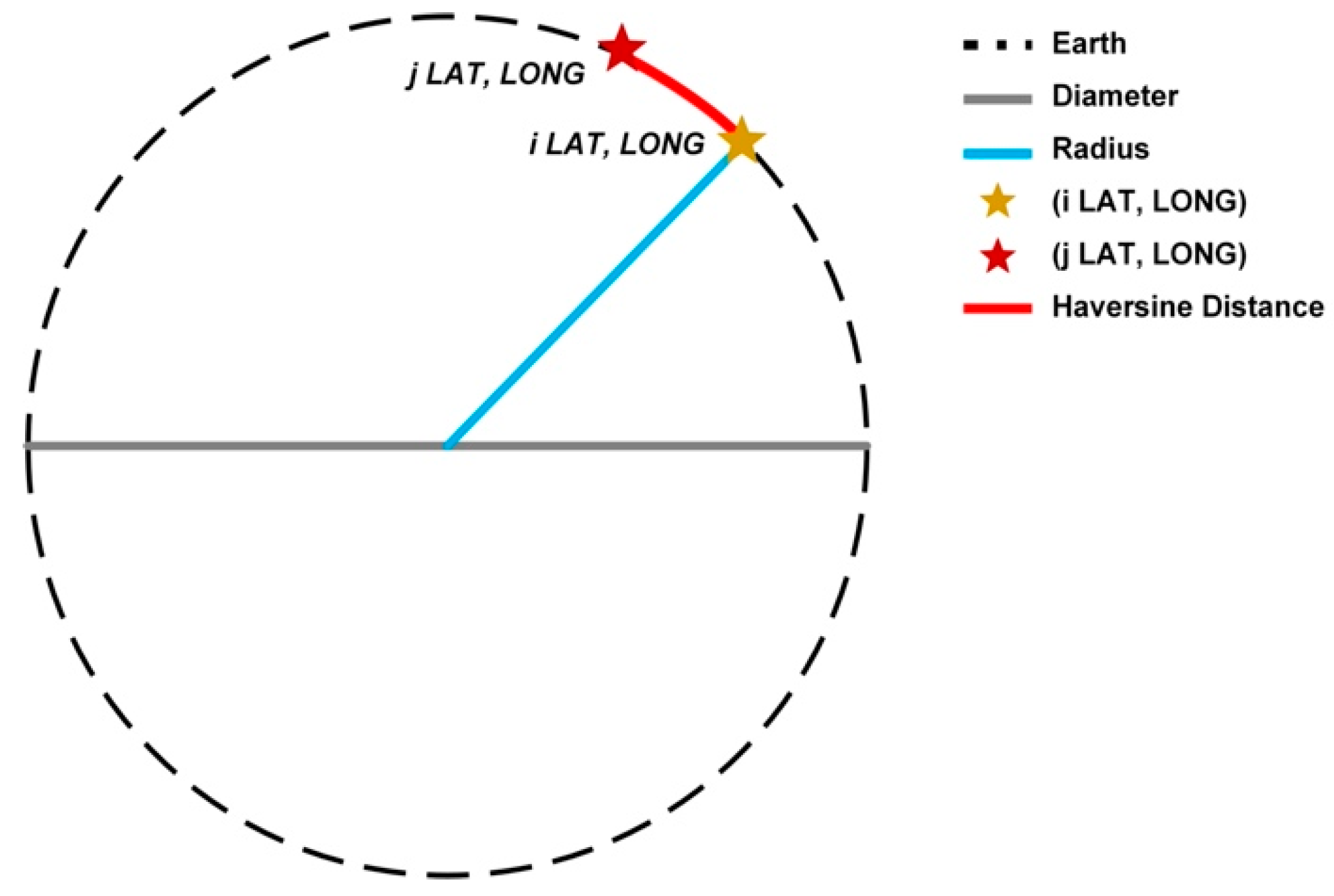
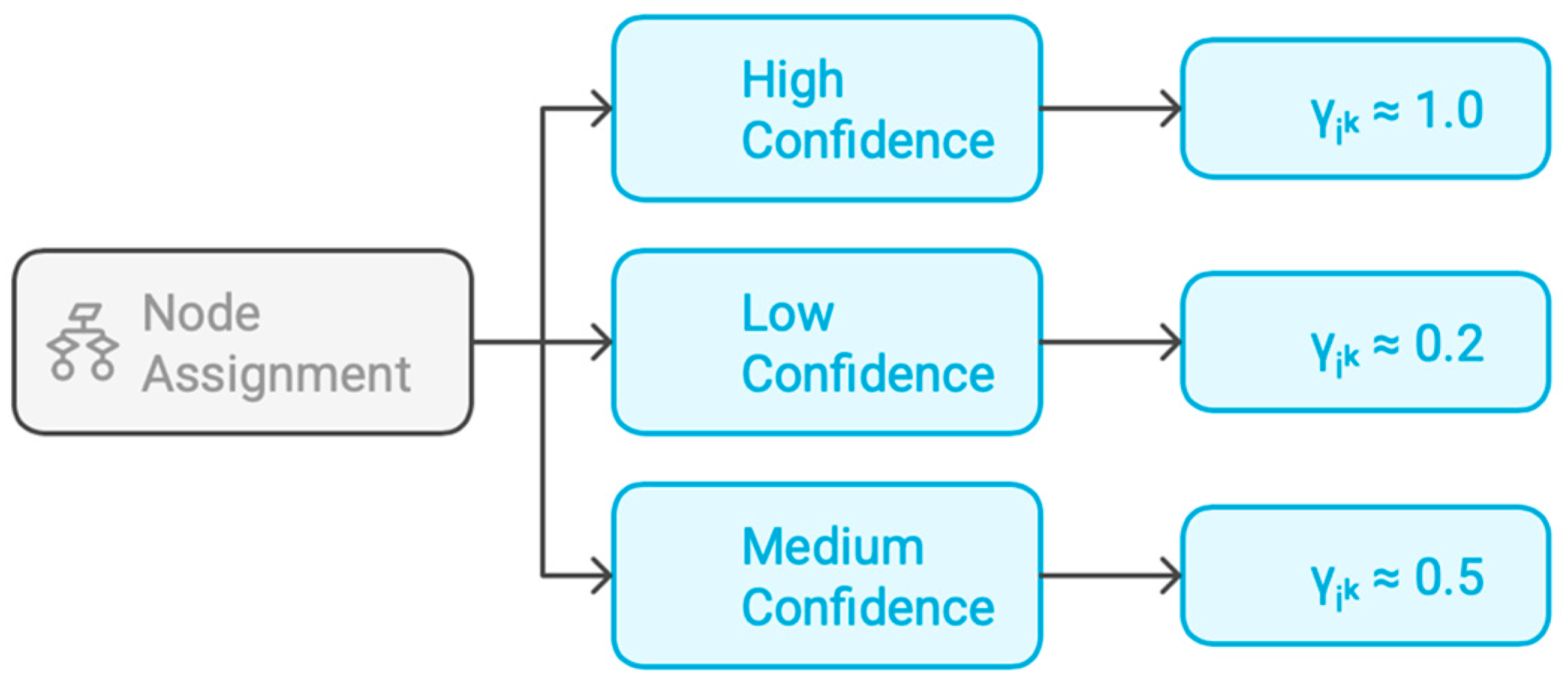

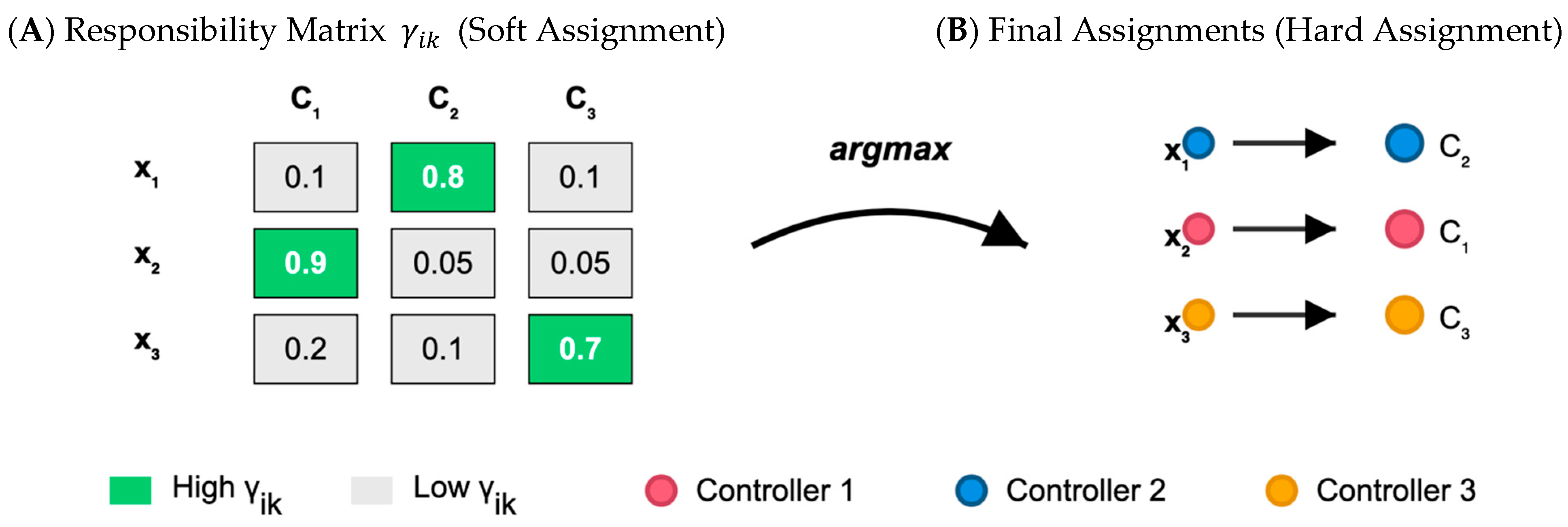

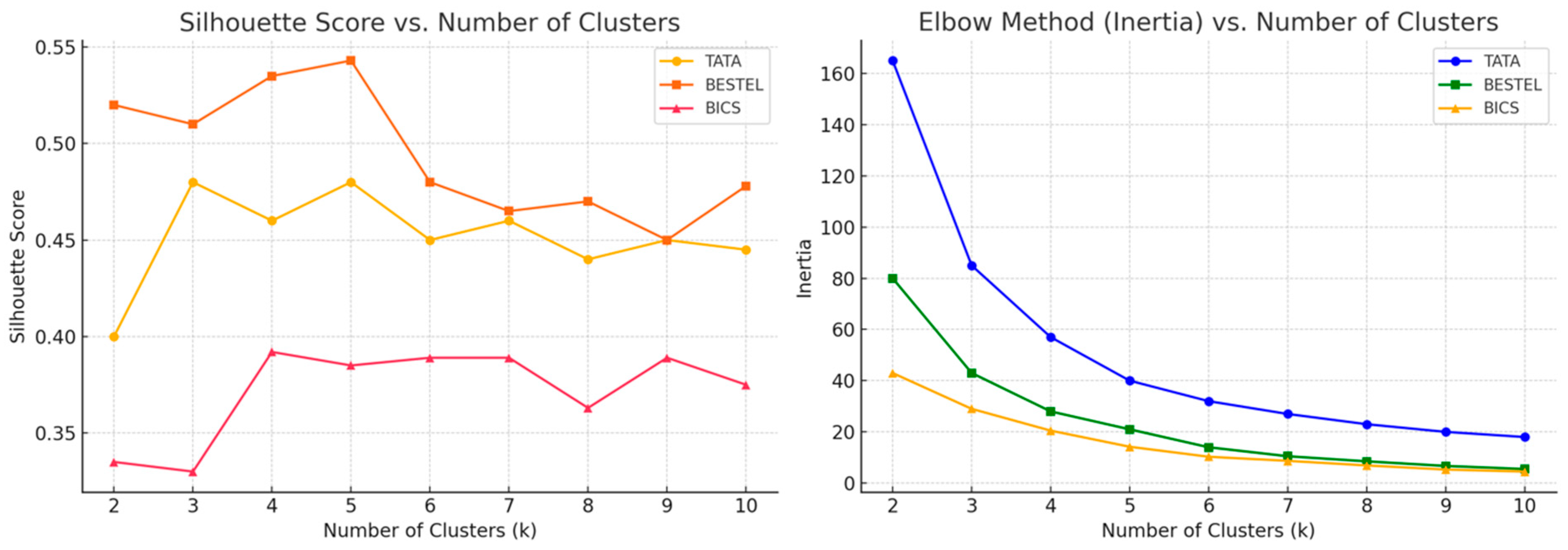
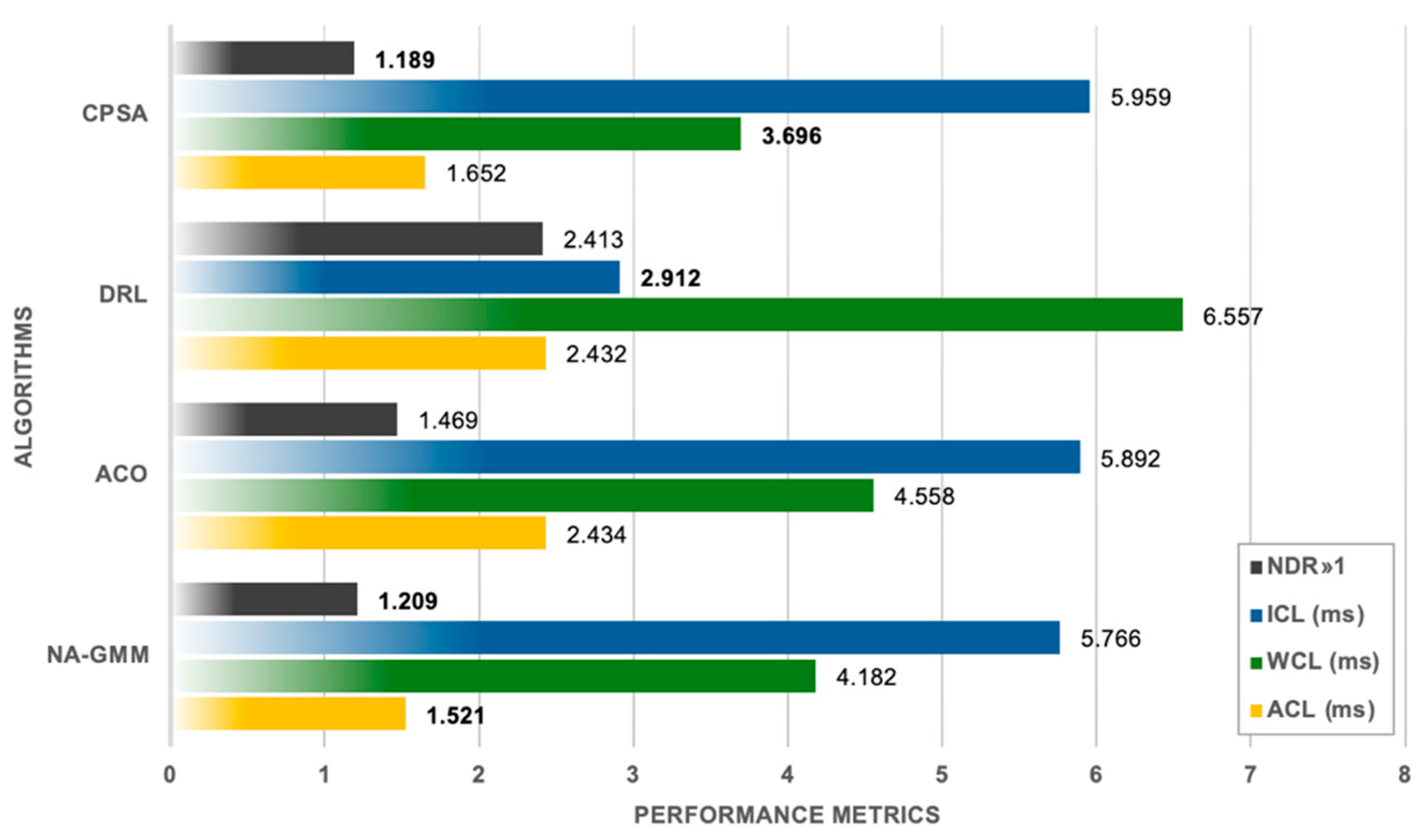


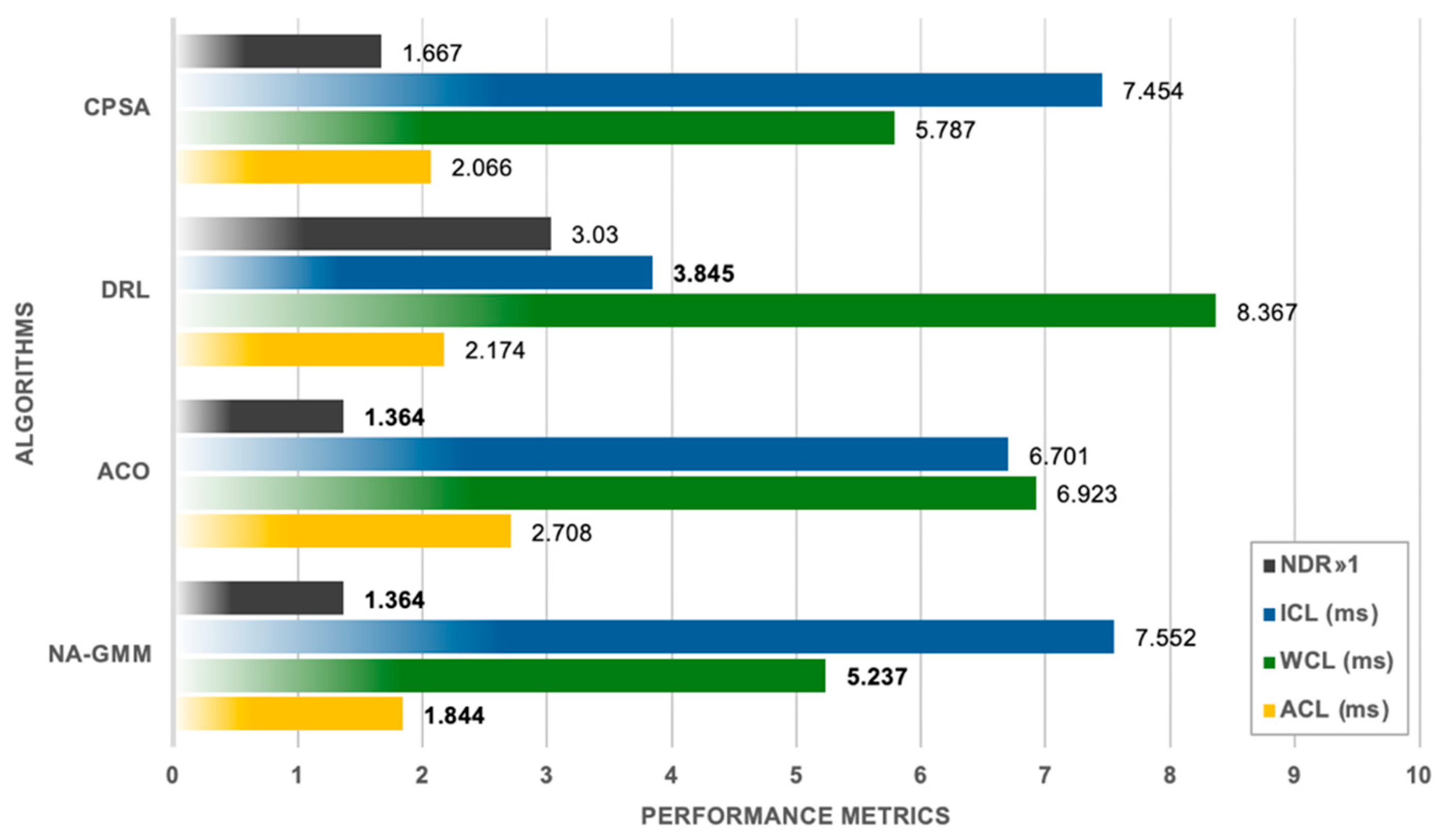

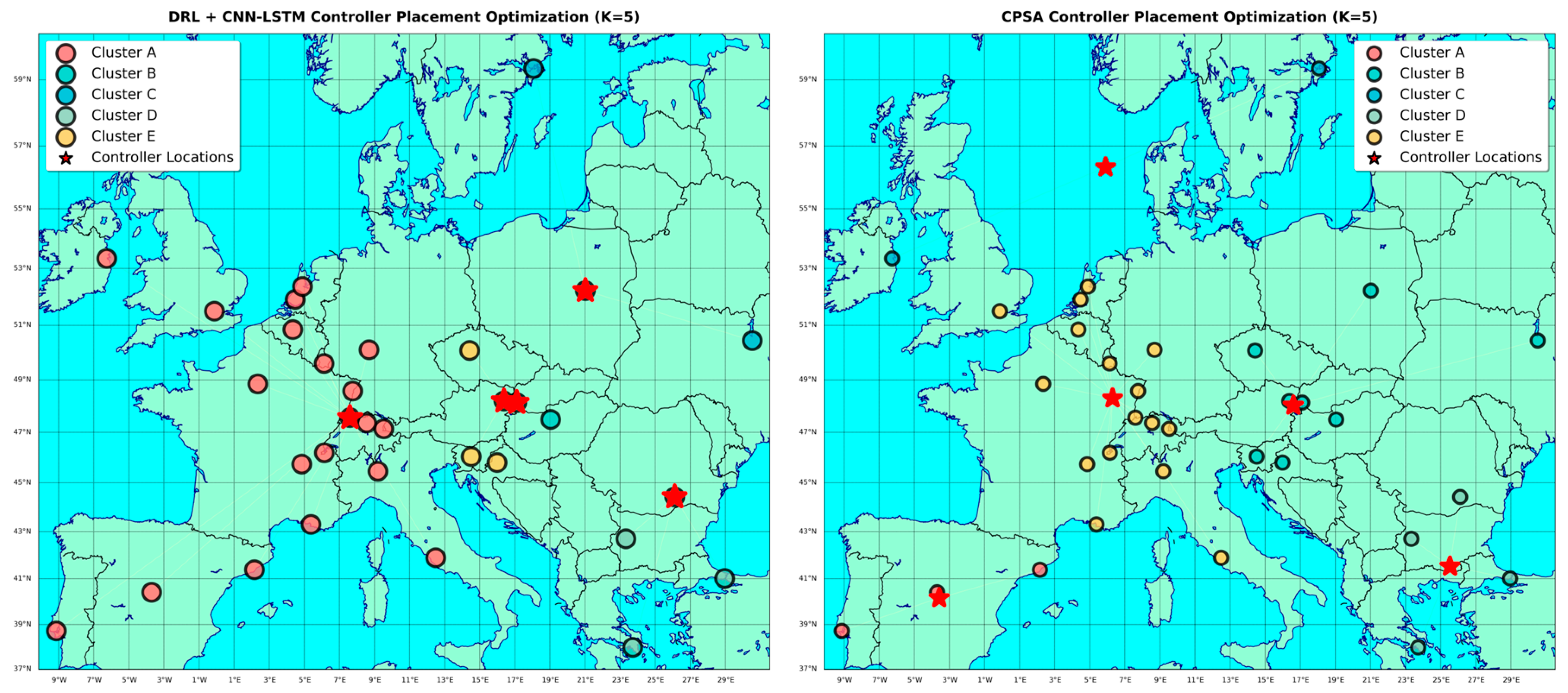
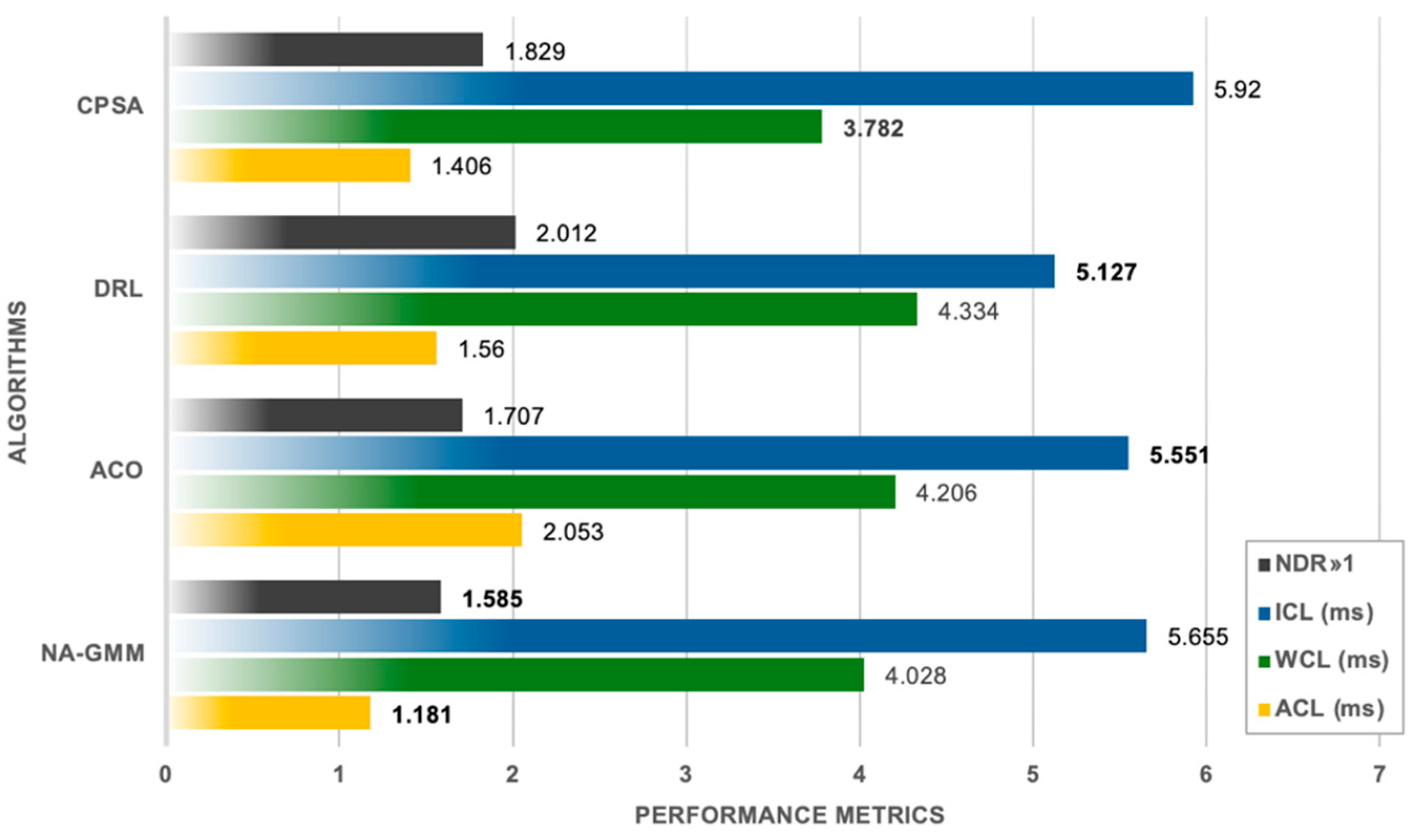
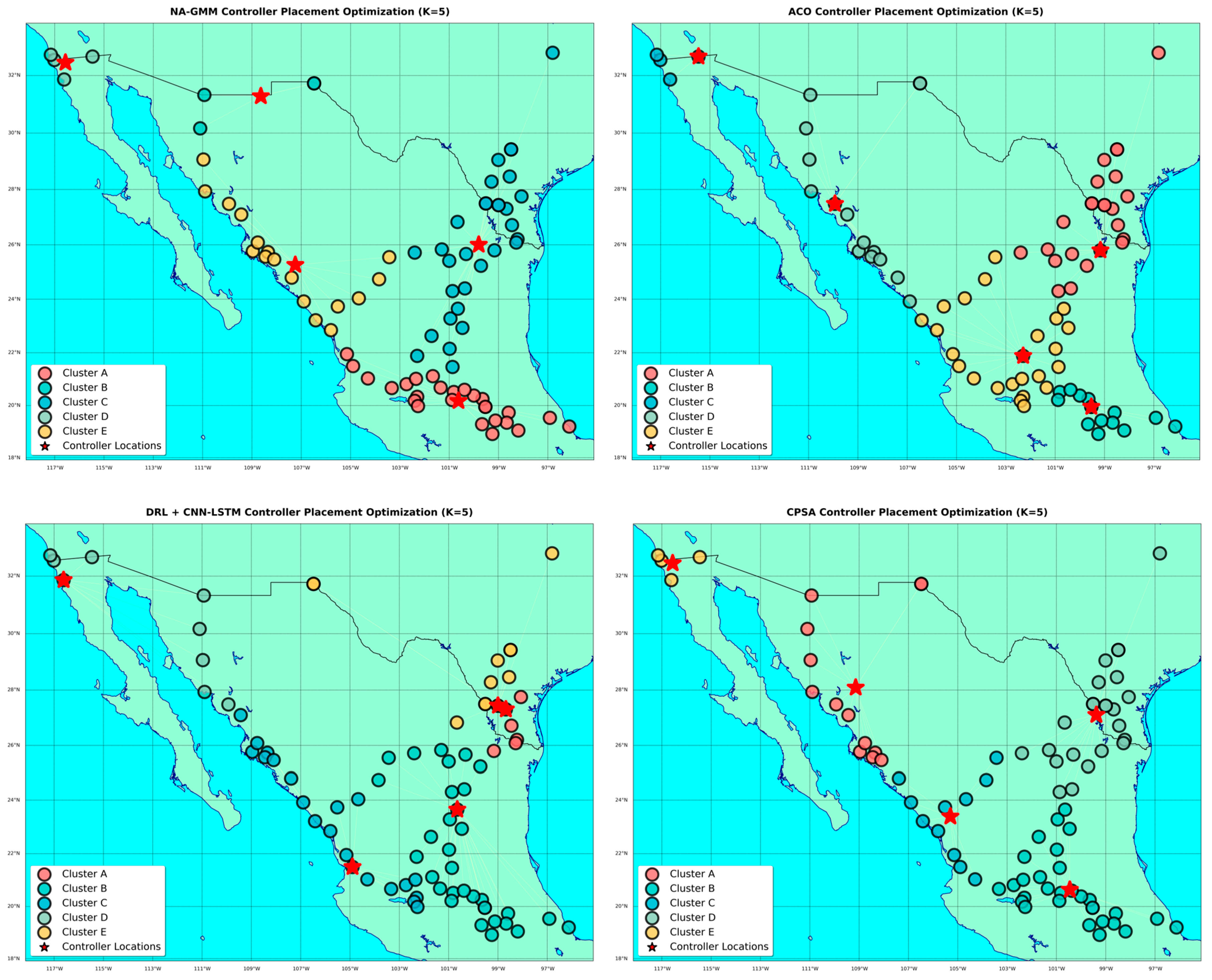

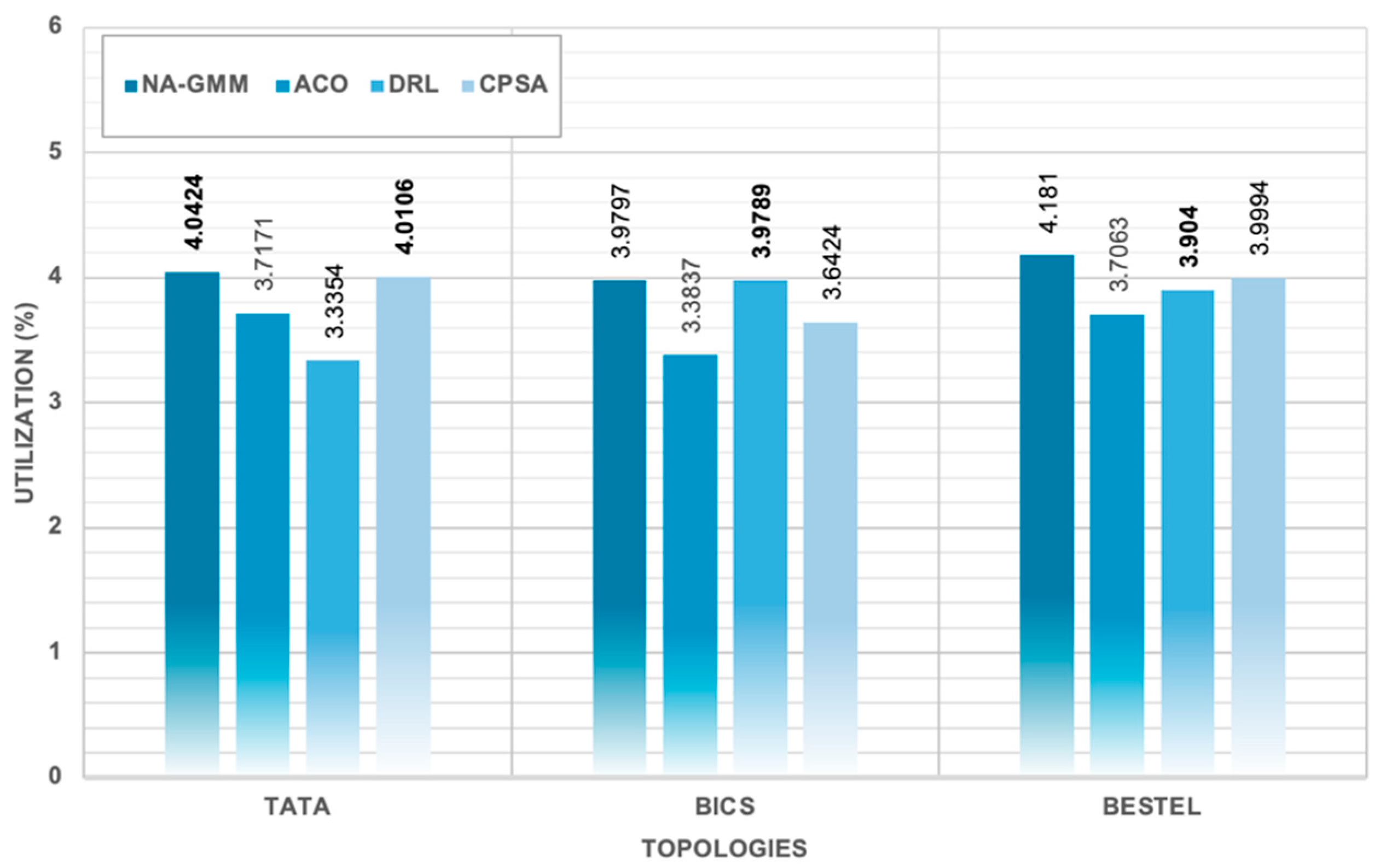
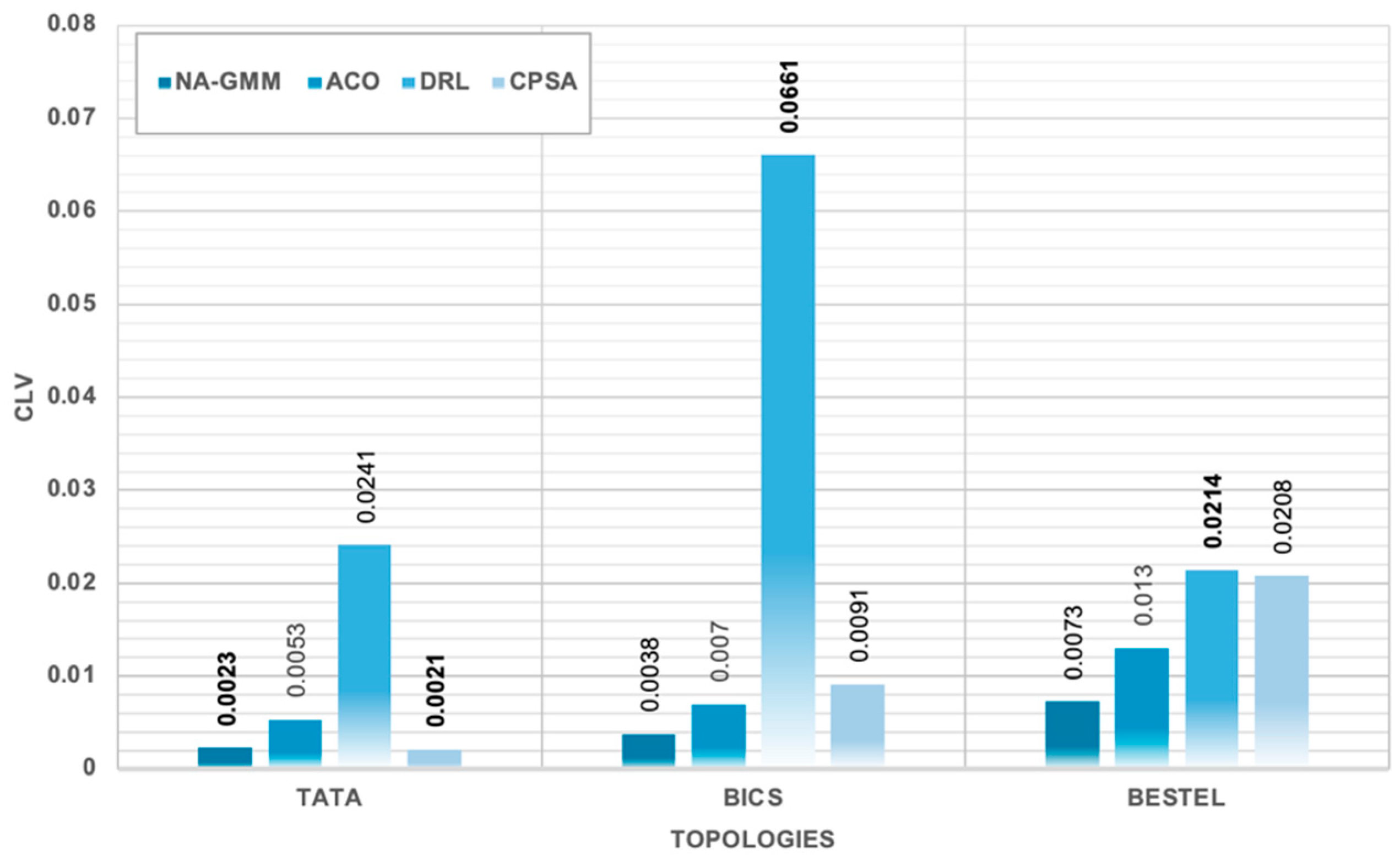
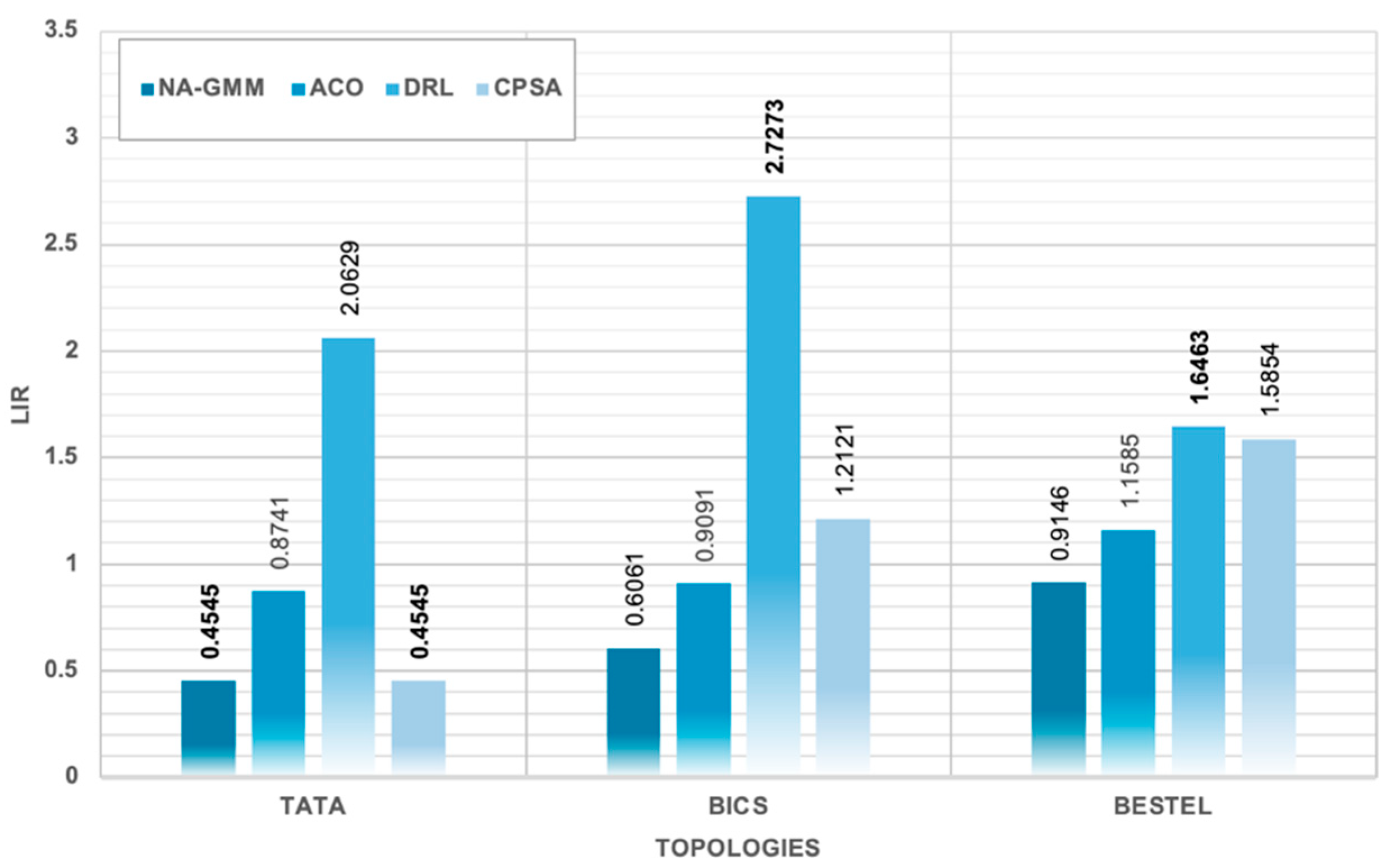

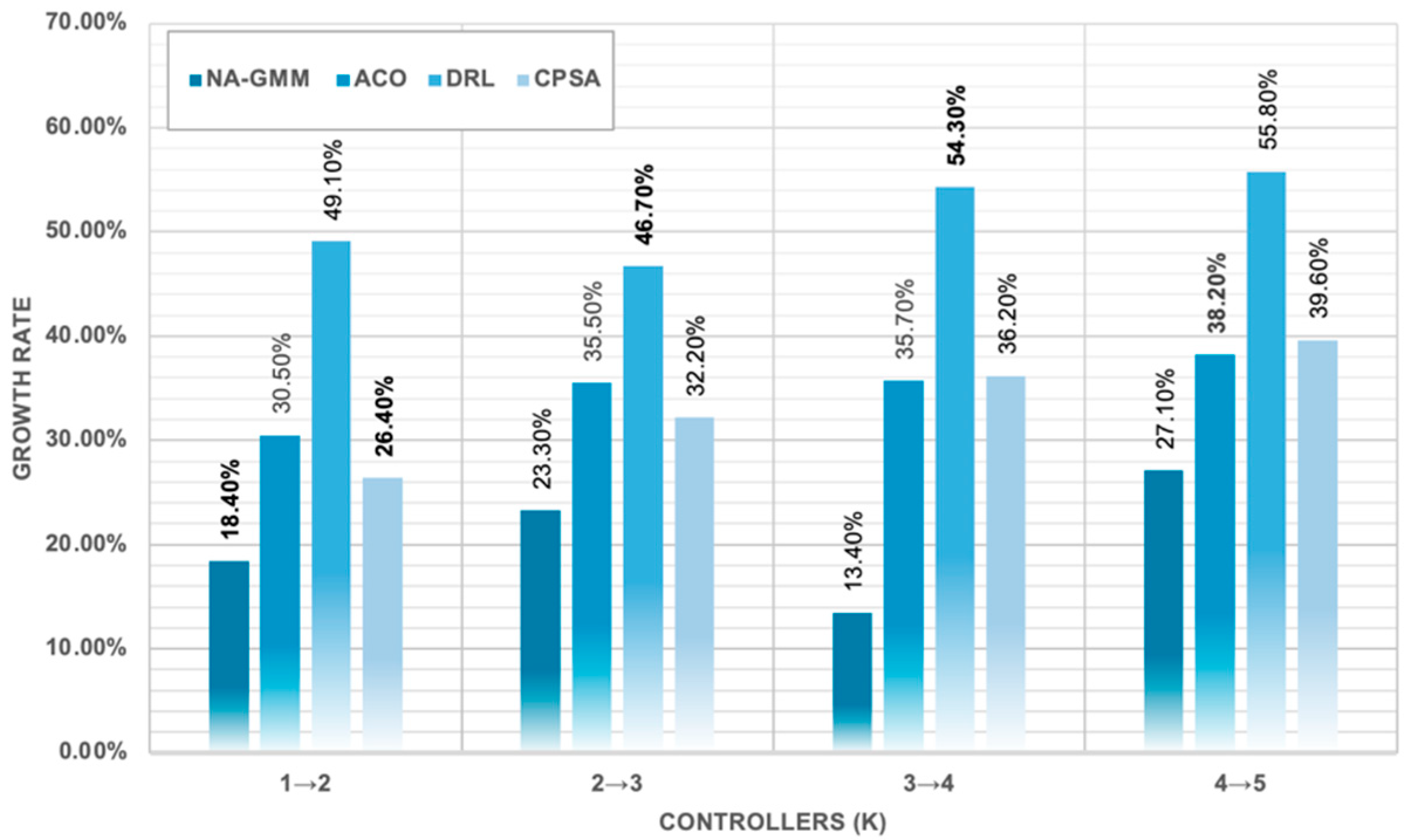

| Ref. | Authors and Year | Method | Distance Metric | Problem Statement | Objectives | Limitations | Gaps |
|---|---|---|---|---|---|---|---|
| [25] | Oladipupo Adekoya and Adel Aneiba (2022) | Adapted NSGA-III with Repair-Based Operator for multi-objective optimization | - | Scalability and diversity challenges in multi-objective controller placement (more than 3 objectives) | Solve scalability for >3 objectives, achieve diverse and convergent Pareto fronts for controller placement | Computational complexity; tested on limited topology (Internet2 OS3E); dynamic adaptation limited | Real-time traffic-aware dynamic placement not addressed; needs integration with network dynamics |
| [31] | Sminesh et al. (2019) | Modified Density Peak (DP) Clustering, Modified Affinity Propagation, Hierarchical k-means | Haversine | High computation in multi-objective placement; clustering approaches need predefined cluster numbers | Adaptive clustering to decide number and placement of controllers minimizing latency, load imbalance | Some methods require predefined cluster counts; static placement ignoring traffic variations | Lack of real-time traffic-aware placement; limited dynamic network support |
| [38] | Ramya and Manoharan (2022) | Traffic-aware dynamic placement using ML prediction + K-Medoid clustering | Euclidean | Static controller placement unsuitable for traffic variability; optimal controller number unknown | Predict required controller count dynamically; place controllers optimally using traffic patterns | Centralized prediction may be bottleneck; relies on traffic prediction accuracy | Scalability to very large networks; limited testing in dynamic environments |
| [45] | Abdulrahman et al. (2025) | Gaussian Mixture Model (GMM)-based placement with hybrid geographic and traffic metrics | Haversine | Healthcare SD-WANs require resilient, low-latency controller placement supporting telemedicine and data access | Increase network efficiency and availability; adapt controller placement to traffic load and network changes | Domain-specific to healthcare; limited benchmarking on non-healthcare topologies | Generalization to other domains; incorporation of emerging network technologies (e.g., 5G, IoT) |
| [46] | Musie Frdiesa (2024) | Ant Colony Optimization (ACO) for controller placement | - | CPP affects overall network performance; existing heuristics fail to optimize latency and load balance jointly | Propose ACO to optimize latency (both switch-controller and inter-controller) and load balancing | Metaheuristic parameters tuning required; convergence speed may vary | Adaptation to dynamic traffic conditions; extension to multi-objective beyond latency and load balancing |
| [47] | Nura Muhammed Yusuf et al. (2023) | Controller Placement with Critical Switch Awareness (CPCSA) using network partitioning | Haversine | Existing CPP algorithms lack switch role awareness leading to inefficiencies in control message overhead | Incorporate switch criticality for network partition and controller placement to reduce overhead and latency | Assumes static switch criticality; may not handle rapid network changes | Dynamic adaptation to traffic and network topology changes; extension to load balancing |
| [48] | Chunlin Li et al. (2024) | Deep Reinforcement Learning (DRL) based controller placement + dynamic edge selection | - | High cost and inefficiency of MEC system management; static controller placement suboptimal | Dynamic controller placement minimizing communication cost and balancing load; optimize MEC task offloading | Requires large training data; complexity of DRL models; real-time deployment overhead | Scalability and transferability to heterogeneous MEC environments; real-time adaptation |
| [49] | Hamza Mokhtar et al. (2021) | Multiple Threshold Load Balancing (MTLB) with switch migration scheme for distributed controllers | - | Load imbalance in distributed SDN controllers leads to performance degradation | Continuous load balancing among controllers; reduce synchronization overhead and migration frequency | Overhead in load information exchange; thresholds tuning needed; complexity in large networks | Integration with CPP methods; real-time responsiveness and stability in highly dynamic networks |
| Variable | Description | Range/Type | Physical Meaning | Usage Context |
|---|---|---|---|---|
| Hybrid Distance Metric Parameters | ||||
| α | Geographic distance weight | [0.4] | Relative importance of physical separation between nodes | Distance computation, regulatory compliance |
| β | Network latency weight | [0.3] | Emphasis on communication delay in controller placement | Performance optimization, QoS requirements |
| γ | Topological cost weight | [0.18] | Routing complexity and path efficiency consideration | Network efficiency, resource optimization |
| δ | Link reliability weight | [0.12] | Network stability and fault tolerance priority | Reliability assurance, SLA compliance |
| dg(i,j) | Geographic distance | ℝ+ | Euclidean distance between network nodes | Spatial relationship modeling |
| dl(i,j) | Network latency | ℝ+ [ms] | Round-trip time between nodes | Performance metric computation |
| dt(i,j) | Topological cost | ℕ | Routing hop count and path complexity | Network topology analysis |
| dr(i,j) | Link reliability | [0, 1] | Inverse reliability measure (higher = less reliable) | Fault tolerance assessment |
| Gaussian Mixture Model Parameters | ||||
| K | Number of controller clusters | ℕ+ | Desired number of controllers in the network | Algorithm initialization, resource planning |
| μk | Cluster mean vector | ℝd | Optimal controller position in feature space | M-step parameter update |
| Σk | Cluster covariance matrix | ℝd × d | Coverage area and correlation structure of cluster k | Cluster shape adaptation |
| πk | Mixing coefficient | [0, 1] | Prior probability and relative importance of cluster k | Load balancing, cluster weighting |
| γik | Responsibility value | [0, 1] | Probability of node i belonging to controller k | E-step computation, soft assignment |
| Nk | Effective sample size | ℝ+ | Weighted number of nodes assigned to cluster k | M-step normalization |
| Algorithm Control Parameters | ||||
| ε | Convergence threshold | ℝ+ | Minimum log-likelihood improvement for termination | Convergence detection |
| t | Iteration counter | ℕ | Current EM algorithm iteration number | Algorithm progress tracking |
| L(t) | Log-likelihood function | ℝ | Quality measure of current parameter configuration | Optimization objective, convergence monitoring |
| θ | Parameter vector | ℝp | Complete set of GMM parameters {μ, Σ, π} | Parameter space representation |
| Network Input Parameters | ||||
| n | Number of network nodes | ℕ+ | Total count of nodes requiring controller assignment | Problem dimensionality |
| d | Feature space dimension | ℕ+ | Dimensionality of network-aware feature vectors | Feature engineering, computational complexity |
| xi | Node feature vector | ℝd | Network-aware representation of node i characteristics | Input data for clustering algorithm |
| DNA | Hybrid distance matrix | ℝn × n | Pairwise network-aware distances between all nodes | Distance computation, feature engineering |
| Configuration | α (Geo) | β (Lat) | γ (Topo) | δ (Rel) | Focus |
|---|---|---|---|---|---|
| Geo-focused | 0.70 | 0.15 | 0.10 | 0.05 | Geographic proximity |
| Lat-focused | 0.15 | 0.70 | 0.10 | 0.05 | Latency optimization |
| Topo-focused | 0.15 | 0.15 | 0.60 | 0.10 | Topology awareness |
| Rel-focused | 0.15 | 0.15 | 0.10 | 0.60 | Reliability priority |
| Balanced | 0.40 | 0.30 | 0.18 | 0.12 | Current (proposed) |
| Equal | 0.25 | 0.25 | 0.25 | 0.25 | Equal weighting |
| Topology | Nodes Count (Red Circles) | Edges Count (Blue Lines) |
|---|---|---|
| TATA | 145 | 194 |
| BICS | 84 | 101 |
| BESTEL | 33 | 48 |
| Algorithm | ACL (ms) | WCL (ms) | ICL (ms) | NDR ≈ 1 |
|---|---|---|---|---|
| NA-GMM | 1.521 | 4.182 | 5.766 | 1.209 |
| ACO | 2.434 | 4.558 | 5.892 | 1.469 |
| DRL | 2.432 | 6.557 | 2.912 | 2.413 |
| CPSA | 1.652 | 3.696 | 5.959 | 1.189 |
| Algorithm | ACL (ms) | WCL (ms) | ICL (ms) | NDR ≈ 1 |
|---|---|---|---|---|
| NA-GMM | 1.844 | 5.237 | 7.552 | 1.364 |
| ACO | 2.708 | 6.923 | 6.701 | 1.364 |
| DRL | 2.174 | 8.367 | 3.845 | 3.030 |
| CPSA | 2.066 | 5.787 | 7.454 | 1.667 |
| Algorithm | ACL (ms) | WCL (ms) | ICL (ms) | NDR |
|---|---|---|---|---|
| NA-GMM | 1.181 | 4.028 | 5.655 | 1.585 |
| ACO | 2.053 | 4.206 | 5.551 | 1.707 |
| DRL | 1.560 | 4.334 | 5.127 | 2.012 |
| CPSA | 1.406 | 3.782 | 5.920 | 1.829 |
| Topology | Algorithm | Throughput (Req/Sec) | Utilization (%) | CLV | LIR |
|---|---|---|---|---|---|
| TATA | NA-GMM | 282.97 | 4.0424 | 0.0023 | 0.4545 |
| ACO | 260.20 | 3.7171 | 0.0053 | 0.8741 | |
| DRL | 233.48 | 3.3354 | 0.0241 | 2.0629 | |
| CPSA | 280.74 | 4.0106 | 0.0021 | 0.4545 | |
| BICS | NA-GMM | 278.58 | 3.9797 | 0.0038 | 0.6061 |
| ACO | 236.86 | 3.3837 | 0.0070 | 0.9091 | |
| DRL | 278.52 | 3.9789 | 0.0661 | 2.7273 | |
| CPSA | 254.97 | 3.6424 | 0.0091 | 1.2121 | |
| BESTEL | NA-GMM | 292.67 | 4.1810 | 0.0073 | 0.9146 |
| ACO | 259.44 | 3.7063 | 0.0130 | 1.1585 | |
| DRL | 273.28 | 3.9040 | 0.0214 | 1.6463 | |
| CPSA | 279.96 | 3.9994 | 0.0208 | 1.5854 |
| Algorithm | Time Complexity | Parameters | Complexity Class |
|---|---|---|---|
| NA-GMM | O(n2k) | n = nodes, k = controllers | Quadratic |
| ACO | O(n2m) | n = nodes, m = ants | Quadratic |
| DRL | O(n3 + s2) | n = nodes, s = state space | Cubic |
| CPSA | O(n2t) | n = nodes, t = iterations | Quadratic |
| Controllers (K) | NA-GMM | ACO | DRL | CPSA |
|---|---|---|---|---|
| 1 | 0.87 | 0.95 | 1.12 | 0.91 |
| 2 | 1.03 | 1.24 | 1.67 | 1.15 |
| 3 | 1.27 | 1.68 | 2.45 | 1.52 |
| 4 | 1.44 | 2.28 | 3.78 | 2.07 |
| 5 | 1.83 | 3.15 | 5.89 | 2.89 |
| Controllers (K) | NA-GMM Growth Rate | ACO Growth Rate | DRL Growth Rate | CPSA Growth Rate |
|---|---|---|---|---|
| 1→2 | 18.4% | 30.5% | 49.1% | 26.4% |
| 2→3 | 23.3% | 35.5% | 46.7% | 32.2% |
| 3→4 | 13.4% | 35.7% | 54.3% | 36.2% |
| 4→5 | 27.1% | 38.2% | 55.8% | 39.6% |
| Average Growth | 20.6% | 35.0% | 51.5% | 33.6% |
| Algorithm | CPU Utilization (%) | RAM Usage (MB) | ||
|---|---|---|---|---|
| Average | Peak | Average | Peak | |
| NA-GMM | 23.4 | 31.8 | 1247 | 1423 |
| ACO | 28.7 | 38.9 | 1456 | 1687 |
| DRL | 42.1 | 58.3 | 2134 | 2578 |
| CPSA | 31.2 | 41.7 | 1623 | 1891 |
Disclaimer/Publisher’s Note: The statements, opinions and data contained in all publications are solely those of the individual author(s) and contributor(s) and not of MDPI and/or the editor(s). MDPI and/or the editor(s) disclaim responsibility for any injury to people or property resulting from any ideas, methods, instructions or products referred to in the content. |
© 2025 by the authors. Licensee MDPI, Basel, Switzerland. This article is an open access article distributed under the terms and conditions of the Creative Commons Attribution (CC BY) license (https://creativecommons.org/licenses/by/4.0/).
Share and Cite
Abdulghani, A.M.; Abdullah, A.; Rahiman, A.R.; Abdul Hamid, N.A.W.; Akram, B.O. Network-Aware Gaussian Mixture Models for Multi-Objective SD-WAN Controller Placement. Electronics 2025, 14, 3044. https://doi.org/10.3390/electronics14153044
Abdulghani AM, Abdullah A, Rahiman AR, Abdul Hamid NAW, Akram BO. Network-Aware Gaussian Mixture Models for Multi-Objective SD-WAN Controller Placement. Electronics. 2025; 14(15):3044. https://doi.org/10.3390/electronics14153044
Chicago/Turabian StyleAbdulghani, Abdulrahman M., Azizol Abdullah, Amir Rizaan Rahiman, Nor Asilah Wati Abdul Hamid, and Bilal Omar Akram. 2025. "Network-Aware Gaussian Mixture Models for Multi-Objective SD-WAN Controller Placement" Electronics 14, no. 15: 3044. https://doi.org/10.3390/electronics14153044
APA StyleAbdulghani, A. M., Abdullah, A., Rahiman, A. R., Abdul Hamid, N. A. W., & Akram, B. O. (2025). Network-Aware Gaussian Mixture Models for Multi-Objective SD-WAN Controller Placement. Electronics, 14(15), 3044. https://doi.org/10.3390/electronics14153044








